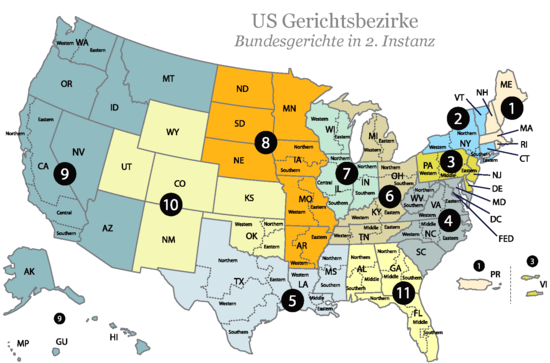United States Court of Appeals
United States Court of Appeals (German Appeals Court of the United States ) is in the United States , the term for appeal of the federal government. Organizationally, they are located in the US federal court structure between the federal courts of first instance ( United States District Courts ) and the Supreme Court . They decide on legal remedies that are filed against judgments of a (usually first instance) federal court or decisions of certain federal authorities.
organization
There are currently twelve general courts of appeal, i.e. those whose jurisdiction relates to a geographic area and not to a specific subject matter . The twelve are each responsible for a judicial district ( circuit, therefore also circuit court or simply circuit ). Eleven of them have numbers (the corresponding court is then called the United States Court of Appeal for the Tenth Circuit ). In addition, there is the court for the District of Columbia with the federal capital Washington , whose outstanding importance derives from its jurisdiction for the many federal authorities located there.
In addition to the federal appeals courts with geographically determined jurisdiction, there is a federal appeals court, whose jurisdiction extends spatially to the entire state of the United States and is factually determined. It is the federal appeals court for the federal district ( Federal Circuit ), which decides on appeals against judgments of certain special first instance federal courts, against judgments of the federal district courts in patent cases as well as in other subject areas.
There are also other courts with the designation United States Court of Appeals with materially specific jurisdiction, which, however, are not comparable with the aforementioned in terms of their legal status. They are courts, the establishment of which is based on the first section of the United States Constitution , that is, on the section on the United States Congress , and are therefore referred to as Section I Courts . The provisions of Section 3 of the Constitution (on the judiciary) do not apply to them, so that, for example, their judges do not have to be appointed for life. The differentiation is justified by the fact that these courts negotiate cases for which (further) judicial proceedings would not be mandatory for constitutional reasons. An important example of such a court of appeal is that military criminal responsible Federal Court of Appeals for the Armed Forces ( United States Court of Appeals for the Armed Forces ) negotiated the appeal against judgments of the Courts of Appeal of the armed forces.
The judicial districts
- Federal District (based in Washington, DC )
- District DC (based in Washington, DC)
- 1st district (seat: Boston )
- 2nd district (based in New York City )
- 3rd district (seat: Philadelphia )
- 4th District (seat: Richmond, Virginia )
- 5th District (based in New Orleans )
- 6th district (based in Cincinnati )
- 7th district (seat: Chicago )
- 8th district (seat: St. Louis )
- 9th district (seat: San Francisco )
- 10th district (based in Denver )
- 11th district (seat: Atlanta )
occupation
The judges are appointed for life by the President with the approval of the Senate. With the exception of the District of Columbia, judges must be residents of the district in which they serve on a permanent basis.
Procedure
Trials in which witnesses and other evidence are presented to a judge or a jury to establish facts only take place in the first instance. Such courts also determine the legal consequences such as sentences (in criminal proceedings) or damages (in civil proceedings).
In the appellate courts, on the other hand, it is only checked whether the subordinate court followed the legal provisions in reaching its judgment. As a result, there are seldom oral hearings, the judges assess the case based on the court record and the written arguments of both parties. The federal appeals courts do not rule on guilt or innocence. If a defendant is found guilty in the first instance, victory in the appeals court does not necessarily mean that he is now presumed innocent; rather, the contested decision is merely set aside. In criminal cases, it is then up to the public prosecutor to decide whether the procedure is repeated ( accusation principle ).
The appeal process is governed by the Federal Rules of Appellate Procedure , a set of rules drawn up jointly by Congress and the Supreme Court . There are usually three appellate judges involved in the proceedings; in some cases the trial takes place jointly before all the judges of the court. Usually there is no appeal from the appellate court to the Supreme Court. However, the parties have the option of taking action against the first-instance judgment by applying to the Supreme Court to be heard again (cf. writ of certiorari ). In exceptional cases, the appellate court can refer the case directly to the Supreme Court without a hearing.
See also
Web links
Individual evidence
- ↑ 28 USC § 44
- ↑ The American System of Government, Chapter 5 The Judiciary. U.S. Department of State Office for International Information Programs, accessed April 15, 2015 .


